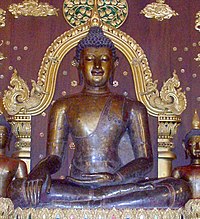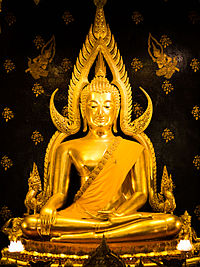Sculpted Images in Sinhalese and Sukhothai Style Thai Art

A Buddha image in Thailand typically refers to three-dimensional stone, forest, clay, or metal cast images of the Buddha. While at that place are such figures in all regions where Buddhism is commonly practiced, the appearance, composition and position of the images vary profoundly from country to country.
Dvaravati period [edit]
During the Dvaravati catamenia (7th through eleventh centuries), at that place were two factions of Buddhism practiced in the region that now encompasses nowadays day Thailand, namely Mahayana and Theravada. The types of images constructed during this era reflects the distinction. Much of the basis for the Buddhist artwork of the Dvaravati period was influence from Buddhist art in Bharat, including the Amaravati and Gupta styles, although there was also local and Khmer influence. Such images include the following classical archetypes:
- Buddha in the Tribhanga (leaning) position with somewhat Indian facial features and no aureole. The correct hand is typically costless, while the left is depicted grasping the Buddha'southward robe.
- Buddha in the Amaravati mode with loosely folded legs and a lotus shaped aureole. Such statues have a continuous eyebrow, a flat olfactory organ and thick lips.
- Square faced cleft chin Buddha with some Khmer features. Legs are typically fully folded. The Buddha sits on a lotus base.
Sri Vijaya images [edit]
Sri Vijaya images are constitute in Southern Thailand Malay Peninsula. They were created between the 8th and thirteenth centuries. Typically, they reverberate the teachings of the Mahayana schoolhouse of Buddhism, which frequently emphasized the veneration of the sacred effigy of Boddhisattvas. The Srivijayan art are noted for its naturalistic style, ideal torso proportions, natural pose and body elegance, and richly adorned jewelries, akin to Indonesian Javanese Buddhist art.
A famous case of Sri Vijayan art is the bronze torso statue of Boddhisattva Padmapani (Avalokiteshvara), eighth century CE Srivijayan art, from Chaiya District, Surat Thani, Southern Thailand. The statue demonstrate the influence of Central Coffee fine art (Shailendra art) . In 1905 Prince Damrong Rajanubhab removed the statue from Wat Wiang, Chaiya, Surat Thani to Bangkok National Museum, Thailand.
Although some of Sri Vijayan Buddhist paradigm were made of bronze and stone, most of Sri Vijaya images were generally made of clay, with less accent on immovability, as their purpose was to benefit the deceased, rather than perpetuate the teachings of the Buddha.[ citation needed ]
Lopburi images [edit]
Lopburi images date dorsum to the eleventh century. They are typically found in Northeast Thailand, and their style is essentially like to Cambodian Buddha images. Such images typically take a cone-shaped cranial protuberance in the form of tiers of lotus petals. The pilus depicted in the images is considerably more than realistic than the pilus of the Dvaravati images, and may be either straight or curly. The face of the Buddha typically has a small grinning, while the earlobes are in unusually large proportion relative to the remainder of the face, often hanging down nearly to the image'south shoulders. A second Lopburi style is the Naga Protected Buddha with the heads of Naga forming a protective taper around the Buddha's head.
Chiang Saen and Lanna images [edit]

Chiang Saen Manner Buddha image
Chiang Saen and Lanna images were created in northern Thailand between the tenth and thirteenth centuries. Early images were similar to the Pala style Buddha images of India, with lotus bud or orb shaped hair curls, round faces, narrow lips and prominent chests. Such images were usually in the subduing Mara position, cantankerous-legged, with the soles of the Buddha'due south feet visible. Many afterward Chiang Saen and Lanna images began to exist constructed from crystals and gemstones.
Two of the most important Buddha images in Thailand, the Emerald Buddha and the Phra Phuttha Sihing are made in the Lanna mode.
Sukhothai period [edit]

During the Sukhothai menstruation (fourteenth century), the fashion of the Thai Buddha images radically inverse due to the influx of new ideas from Sri Lankan Buddhism. Buddha images were cast with the intention of depicting superhuman traits of the Buddha, and were designed to express compassion and tranquility in posture and facial expression. The Sukhothai menses witnessed the innovation of the four modern postures of the Thai Buddha, i.eastward. walking, standing, sitting and reclining. Images often had a flame-shaped aureole, finely curled hair, a slight grinning, broad shoulders and an oval face. A common pose was the subduing Mara, with the Buddha seated on a manifestly base. Notable variations within the Sukhothai menstruation include the Kamphaengpet, the Phra Buddha Chinnarat (such as the most famous Chinnarat at Wat Phra Sri Rattana Mahatat Woramahawihan), and the Wat Ta Kuan groups of images.
Wat Traimit Golden Buddha, which is a famous tourist allure in Bangkok, is fabricated in the Sukhothai fashion, so it may indeed date from that period.
U Thong images [edit]
There are iii categories of U Thong images from the twelfth through fifteenth century in central Thailand. The first such way was a fusion of the Dvaravati and Central khmer fashion images. They would typically adorn a lotus bud aureole and Khmer facial features. The second style was similar to the Lopburi images. The tertiary and most recent U Thong style had considerable influence from the Sukhothai images, but oftentimes had pilus bands unique to U Thong images.
Ayutthaya menses [edit]

Big Buddha in Wat Phanan Choeng, Ayutthaya
Ayutthaya images were created between the tenth and eighteenth centuries. They had a unique hair frame and tell-tale narrow carvings in a higher place the lips and eyes. Early Ayutthaya images were carved in stone with heavy influence from the Lopburi images. Heart Ayutthaya images were similar to the Sukhothai images, and were in like poses. During this period, the images were oftentimes cast in Bronze, and the size of the images were frequently large. In the late Ayutthaya menstruum, the images typically depicted the Buddha in regal attire, and the bases of the images diameter ornate design.
Modernistic Thai Buddha images [edit]
In modern times, Buddha images are frequently replicas of images from the Sukhothai and other early on periods, often more than ornately and elaborately adorned. Faces in new innovative depictions are typically more realistic and human-like. An elongated flame aureole is pop. Robes depicted in modern images frequently describe floral designs. The Indian Gandhara style, too as western art have also influenced many of the modern images.
Bunleua Sulilat'south concrete sculpture gardens (Buddha Park and Sala Keoku) give an case of contemporary highly creative and unconventional artistic handling of Buddhist subjects. See besides Wat Rong Khun and Sanctuary of Truth.
See also [edit]
- Iconography of Gautama Buddha in Laos and Thailand
- Buddhist Art
- Buddhism in Thailand
- Luang Phor Phet are statues of the Buddha depicted in the (Diamond) Lotus Position or Vajrāsana
- Lao Buddhist sculpture
- Attitude of Buddha in Thai art (ปางพระพุทธรูป; paang phra phutta roup)
- Leela attitude
- Maravijaya attitude
References [edit]
- The Thai Buddha Image
External links [edit]
- Eight Eras of Thai Buddhist Art and Sculpture
- Thai Buddha Images for the Days of the Calendar week [1]
Source: https://en.wikipedia.org/wiki/Thai_Buddhist_sculpture
0 Response to "Sculpted Images in Sinhalese and Sukhothai Style Thai Art"
Post a Comment